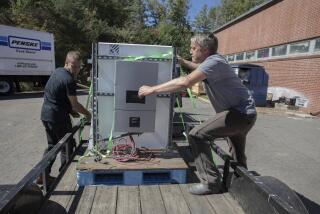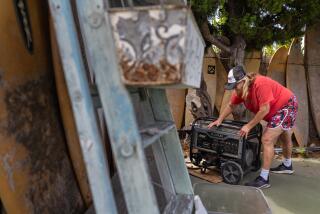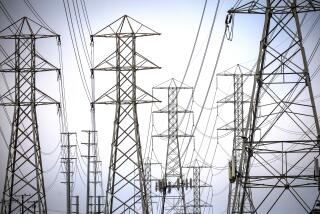COLUMN ONE : Unplugged and Living Off the Sun : In rural California, surge in homemade energy is fueled by improved technology and lower costs. Even big utility companies are awakening to the potential.
ARCATA, Calif. — Linda Parkinson and her family are unplugged, and that’s the way they like it.
Surrounded by redwood trees and their bountiful organic garden, they live in a sunny, two-story wood house in the coastal hills of Humboldt County and have no need for a power company: They make all their electricity themselves.
With a solar panel array that tracks the sun and a bank of batteries to store energy, Parkinson, her husband, Michael Kirschner, and their two boys, 4 and 8, can produce enough wattage to power a 1990s way of life--including a personal computer, stereo and VCR.
“We started out to be self-sufficient,” said Parkinson, 39, a wildlife artist who built much of the family’s house herself. “Now it’s part of our lifestyle. We don’t even think about it anymore.”
Alternative power--hailed in the 1970s as the nation’s energy savior and scorned in the ‘80s for falling short of its promise--is quietly making a comeback in the backwoods of California.
In this environmentally conscious community 285 miles north of San Francisco, Parkinson and her family are on the frontier of energy independence. Statewide, theirs is among an estimated 20,000 households producing their own power through the steadily improving technology of photovoltaic panels, compact waterwheels and small-scale wind turbines.
Home energy enthusiasts call it living “off the grid”--the network of power plants and transmission lines that connects nearly every household in the United States--and industry analysts say the number is rising each year.
With solar power still more pricey than commercial electricity, the biggest surge in homemade energy has come in rural areas, where setting up a miniature power plant costs less than bringing in power lines.
Solar power users run the gamut from business people and retirees to architects and survivalists. Recreational vehicle owners rely on solar energy to run their refrigerators and televisions; government agencies routinely use it to power such facilities as freeway emergency phones, Forest Service lookout stations and remote military installations.
In California, the movement toward energy independence is strongest in North Coast counties such as Humboldt and Mendocino, where hippies sought refuge from urban life as part of the “back-to-the-earth” movement of the 1960s and ‘70s.
Once content to read by kerosene lamp and warm themselves by wood stove, many of these aging rebels have installed solar energy systems that allow them to live in modern comfort--without sacrificing their counterculture ideals.
Except for the telltale solar panels perched on a pole--and the bumper sticker proclaiming “I GET MY ELECTRICITY FROM THE SUN”--Parkinson and Kirschner’s home looks like a house fed by the grid.
Indoors, the boys play downstairs, the washing machine whirs in the background and the parents make turkey sandwiches. With the quietude of passive solar, there is no hint the house runs on home-made power.
“Theoretically, if we had everything running, we could go five days without sun at all,” said Parkinson, who grew up in Santa Ana. “Sometimes I leave lights on overnight on purpose because the batteries are overloaded.”
David Katz, a long-haired, full-bearded former Navy engineer, escaped from the Bay Area two decades ago and moved to southern Humboldt County when land was just $300 an acre. He devised a solar power system for his home that was so envied by his neighbors that he soon had a thriving business installing similar systems for them. Now 44, he has 20 employees and ships energy components around the world.
“Almost every house on every dirt road around here has solar power,” Katz said as he walked among shelves of photovoltaic panels and waterwheels at his new warehouse in Redway, about 75 miles south of Arcata. “There are a lot of people here who want to be independent from the authorities.”
For most home power users, setting up a solar system is a matter of simple economics.
A few years back, Richard Perez, editor of Home Power magazine, calculated that it made economic sense to install a home energy system if a house was four miles or more from the grid; any closer than that and it was cheaper to run power lines and plug into a utility company.
But over time, the cost of alternative energy has steadily dropped and the cost of extending power lines into remote areas has soared to as much as $100,000 a mile--and up to $1 million a mile if the lines are underground. Now, Perez figures, it is cost-effective to install a home power system--at a cost of $10,000 to $15,000--if a house is as close as an eighth of a mile from the grid.
Now, Perez and other devotees look forward to the day when it will be cost-effective for city folk to install home energy systems, produce electricity for household use and sell their surplus to utility companies.
“This stuff is rapidly becoming mainstream,” said an optimistic Perez, whose magazine has become a bimonthly bible for the solar power crowd. “Technology has made it possible for small-scale producers to contribute to the grid or live off the grid. All we need is a major drop in [the price]. Then every garage roof can become a power-producer.”
Already, the phenomenon is not limited to remote areas. Putting principle ahead of economics, a few environmentally conscious residents in urban areas have begun seceding from the grid and setting up home power systems.
Despite the higher cost, they argue that solar power is cheaper from a social standpoint because it does not have the environmental costs associated with commercial power production.
“I don’t consume fossil fuels, I don’t support nuclear power, and it feels very good,” said environmental activist Michael Welch, a veteran of California’s anti-nuclear protests who recently took his Arcata home off the grid. “I can run the same appliances and lighting that anybody else can, but I make all my own electricity.”
Even big utility companies are awakening to the potential. Southern California Edison surveyed its service area and found 5,600 homes off the grid, mostly in the desert and mountain regions. Looking to the future, it has begun selling photovoltaics--PV for short--to customers in remote areas.
The Sacramento Municipal Utility District has recruited 250 homeowners willing to pay $6 a month for the privilege of becoming experimental solar power generators. Hoping that they can contribute to the development of solar power, these customers have allowed the utility to install solar panels on their roofs to produce power for the utility--even though none of the energy goes directly to their homes.
“We call them PV pioneers,” said the utility’s general manager, Jan Schori. “Not only do they give us their roofs for free, they agree to pay us a little more on their bill. The people are very motivated and enthusiastic.”
Trying to spur interest among city dwellers, Gov. Pete Wilson signed legislation in August that will end the utility companies’ two-tier pricing system for home energy producers.
Because electricity travels both directions on utility company lines, solar power generators with electric service can use the grid as their “battery” to store energy and as a backup system during cloudy weather. They can even sell their surplus to the utility company.
But until now, utilities have valued homemade electricity at about one-fourth of the price they charge for electricity. Utilities also have required power-generating customers to install two meters--one to measure electricity supplied by the utility and a second to track homemade energy received by the company.
Under the new law, which goes into effect in January, all homes will have a single meter that will measure electricity traveling in both directions. Power produced by the home will have the same value as electricity sold by the utility, so a home that makes as much energy as it consumes will pay nothing. If a home generates more power than it uses during a billing period, the utility can buy the surplus at a lower, wholesale rate.
Supporters of solar power say the technology and economics of photovoltaics can only improve.
“The price of homemade electricity is going down, down, down and the price of utility company energy is going up, up, up,” said the tall, bearded Welch, who runs the office of the environmental group Redwood Alliance in Arcata. “The kicker is going to be when it’s economical. Then people who don’t care about the environment will be helping out.”
Typically, off-the-grid power systems include solar panels, batteries and an inverter to convert the electricity into the kind of current used by most appliances. Such systems can easily be enlarged; many people start with just a couple of solar panels and batteries and gradually add more.
Most also use propane to run some appliances and have some combination of backup power, ranging from a wood stove or gasoline-powered generator to a sophisticated wind turbine or creek-side waterwheel.
When Linda Parkinson built her home in 1979 up a gravel road four miles east of Arcata, Pacific Gas & Electric told her it would cost $15,000 to run an underground power line to her house.
Instead, the slender, brown-haired artist installed a modest solar system--but it was far from perfect. When the weather was cloudy, it ran low on power. Too often in the evenings, the television picture would slowly begin to shrink until it vanished--or until someone went outside and fired up the generator.
When she and her husband remodeled their home in 1993, they upgraded their power system, increasing their solar panels to eight and installing 10 45-pound batteries. Their total cost was $10,000--still considerably less than PG&E;’s price. Even better, they have no monthly electric bill.
Like most others, their system requires little maintenance--and keeps producing power even when utility companies are experiencing blackouts.
They use propane to run their water heater, refrigerator and stove. Usually they have energy to burn and seldom worry about turning off lights, the stereo or television. Only rarely do they start up their generator.
But like most solar power users, it has become second nature for them to keep track of the weather and plan their energy use. They save the energy-guzzling task of ironing for sunny days when they have a power surplus. And until they buy a more sophisticated inverter that can produce current more closely matching the kind demanded by certain touchy appliances, they cannot use such devices as laser printers.
“We don’t have a lot of frills, but we’re not suffering,” said Parkinson, as she gazed out on the garden and the redwoods beyond. “It’s as extravagant a lifestyle as I need.”
(BEGIN TEXT OF INFOBOX / INFOGRAPHIC)
Solar Power at Home
In simple terms, this is how a solar energy system works:
1) When the sun hits a photovoltaic (or solar) panel, the silicon wafers transform solar energy into electricity.
2) The electricity then travels to batteries, where it is stored.
3) When needed, the electricity goes to an inverter, which changes the voltage from 12-volt to standard household current. The electricity is then distributed to lights, outlets and appliances.
4) Most systems also have backup power, such as a gasoline-powered generator, a small waterwheel or wind turbine, or even a utility company.
More to Read
Inside the business of entertainment
The Wide Shot brings you news, analysis and insights on everything from streaming wars to production — and what it all means for the future.
You may occasionally receive promotional content from the Los Angeles Times.










